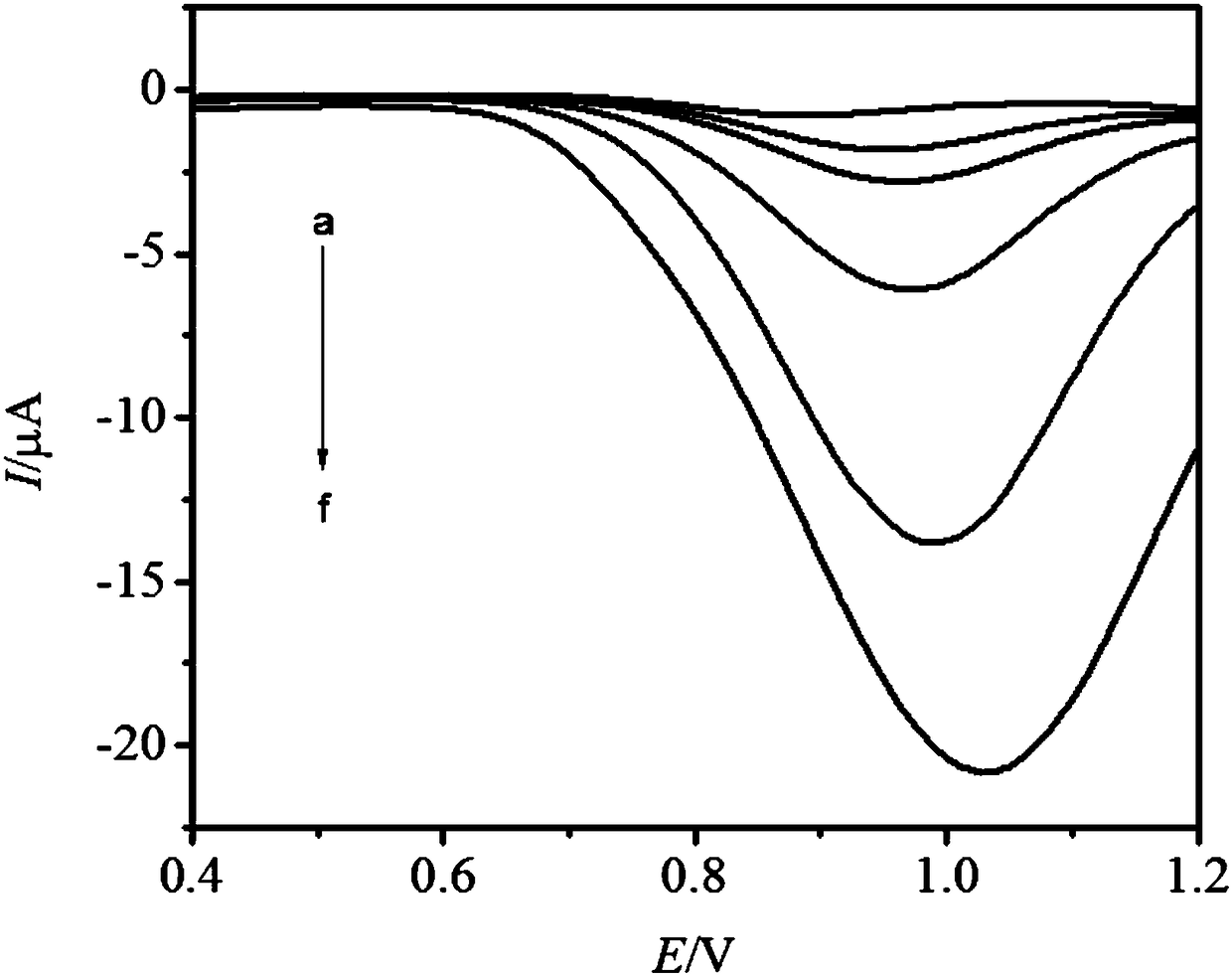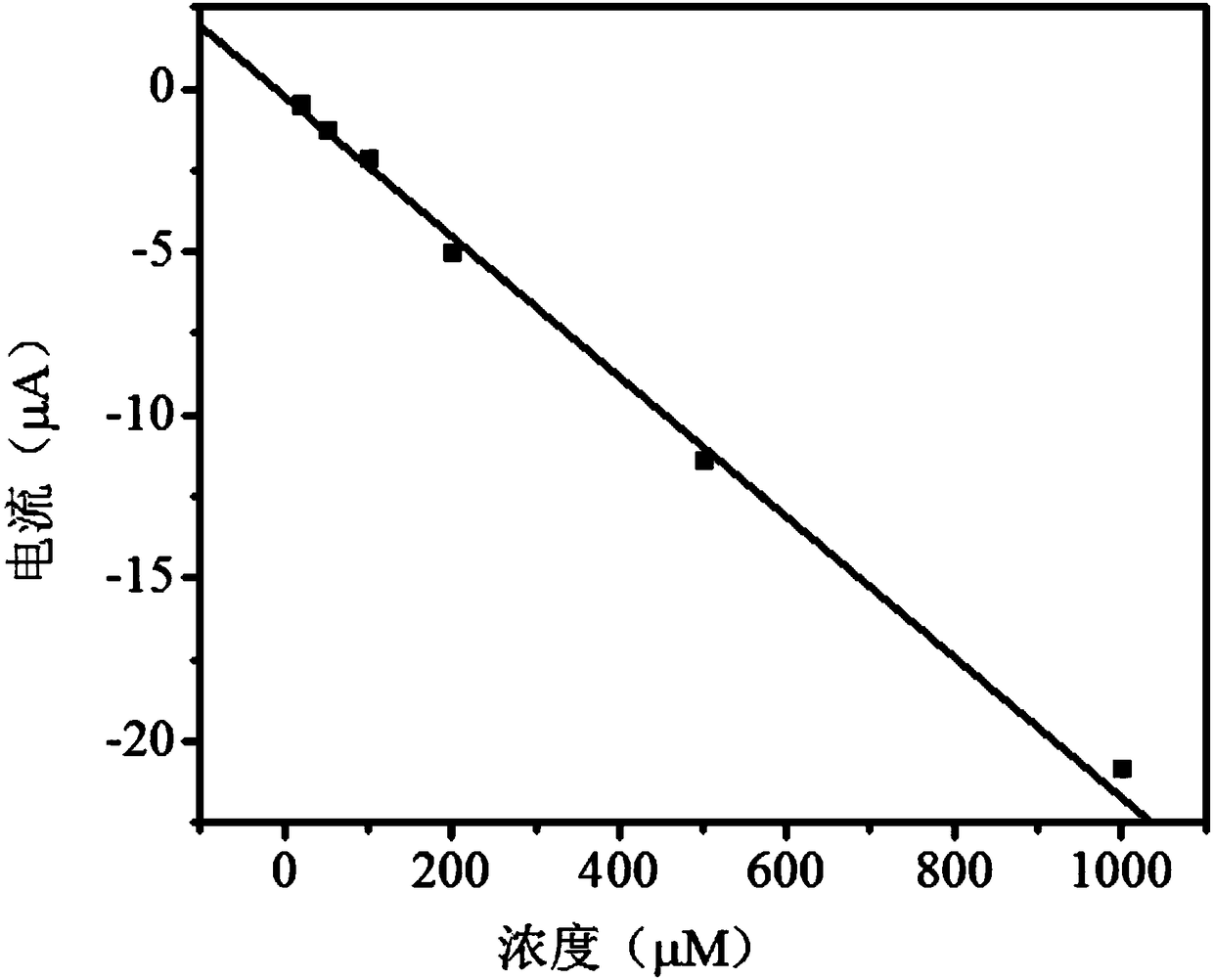Method for detecting nitrite ion concentration in solution
A technology of nitrite ion and concentration, which is applied in the detection of nitrite ion concentration in solution, and in the field of electrochemical sensing of glassy carbon electrodes. Large overpotential and other issues, to achieve the effect of fast electron transfer, promotion of electron transfer, and good electrochemical stability
- Summary
- Abstract
- Description
- Claims
- Application Information
AI Technical Summary
Problems solved by technology
Method used
Image
Examples
Embodiment 1
[0035] A carboxylated graphene / polypyrrole / chitosan modified electrode, the preparation method comprising the following steps:
[0036] S1: Mix 0.8mg carboxylated graphene with 4mL pyrrole and soak in ethanol solution, then add 0.08mol / L ferric chloride solution to polymerize polypyrrole on the surface of carboxylated graphene, stir at room temperature for 50min, add Deionized water, highly centrifuged and repeated several times until the supernatant was clear and the pH was neutral, separated to obtain the lower precipitate, and dried in vacuum at 55°C to obtain carboxylated graphene-polypyrrole;
[0037] S2: Dissolving 3 mg of carboxylated graphene-polypyrrole in 0.8 mL of a chitosan solution with a mass fraction of 0.5 wt%, and ultrasonicating for 50 minutes to obtain a carboxylated graphene-polypyrrole-chitosan mixed solution;
[0038] S3: Take 3 μL of the carboxylated graphene-polypyrrole-chitosan mixture and titrate it on the glassy carbon electrode, and dry it to obtain...
Embodiment 2
[0041] A carboxylated graphene / polypyrrole / chitosan modified electrode, the preparation method comprising the following steps:
[0042] S1: Mix 1.2mg carboxylated graphene with 4mL pyrrole and soak in ethanol solution, then add 0.12mol / L ferric chloride solution to polymerize polypyrrole on the surface of carboxylated graphene, stir at room temperature for 70min, add Deionized water, highly centrifuged and repeated several times until the supernatant was clear and the pH was neutral, separated to obtain the lower precipitate, and dried in vacuum at 65°C to obtain carboxylated graphene-polypyrrole;
[0043] S2: 5 mg of carboxylated graphene-polypyrrole was dissolved in 1.2 mL of a chitosan solution with a mass fraction of 0.5 wt%, and ultrasonicated for 70 minutes to obtain a carboxylated graphene-polypyrrole-chitosan mixture;
[0044] S3: Take 5 μL of the carboxylated graphene-polypyrrole-chitosan mixture and titrate it on the glassy carbon electrode, and dry it to obtain the ...
Embodiment 3
[0047] A carboxylated graphene / polypyrrole / chitosan modified electrode, the preparation method comprising the following steps:
[0048] S1: Mix 1.0mg carboxylated graphene with 4mL pyrrole and soak in ethanol solution, then add 0.1mol / L ferric chloride solution to polymerize polypyrrole on the surface of carboxylated graphene, stir at room temperature for 60min, add Deionized water, highly centrifuged and repeated several times until the supernatant was clear and the pH was neutral, separated to obtain the lower precipitate, and dried in vacuum at 60°C to obtain carboxylated graphene-polypyrrole;
[0049] S2: Dissolve 4 mg of carboxylated graphene-polypyrrole in 1 mL of a chitosan solution with a mass fraction of 0.5 wt%, and ultrasonicate for 60 minutes to obtain a carboxylated graphene-polypyrrole-chitosan mixture;
[0050] S3: Take 4 μL of the carboxylated graphene-polypyrrole-chitosan mixture and titrate it on the glassy carbon electrode, and dry it to obtain the carboxyla...
PUM
| Property | Measurement | Unit |
|---|---|---|
| particle size | aaaaa | aaaaa |
Abstract
Description
Claims
Application Information
 Login to View More
Login to View More - R&D
- Intellectual Property
- Life Sciences
- Materials
- Tech Scout
- Unparalleled Data Quality
- Higher Quality Content
- 60% Fewer Hallucinations
Browse by: Latest US Patents, China's latest patents, Technical Efficacy Thesaurus, Application Domain, Technology Topic, Popular Technical Reports.
© 2025 PatSnap. All rights reserved.Legal|Privacy policy|Modern Slavery Act Transparency Statement|Sitemap|About US| Contact US: help@patsnap.com


